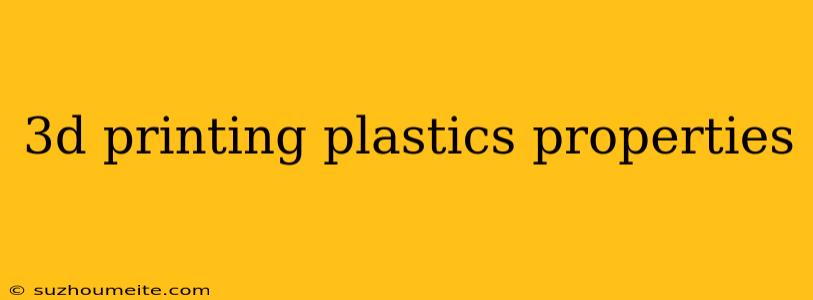3D Printing Plastics Properties: Understanding the Characteristics of Different Materials
Introduction
Three-dimensional (3D) printing has revolutionized the manufacturing industry, allowing for the rapid creation of complex shapes and structures with high accuracy. One of the key components of 3D printing is the material used, with plastics being one of the most popular choices. However, different plastics have varying properties that affect their performance in 3D printing. In this article, we will delve into the properties of various 3D printing plastics, exploring their strengths, weaknesses, and applications.
Thermoplastics
Thermoplastics are a type of plastic that can be melted and reformed multiple times without undergoing any significant chemical change. They are the most commonly used materials in 3D printing.
ABS (Acrylonitrile Butadiene Styrene)
- Properties:
- High impact resistance
- Good heat resistance
- Easy to process
- Relatively inexpensive
- Applications:
- Consumer products (e.g., phone cases, toys)
- Automotive parts
- Medical devices
- Weaknesses:
- Prone to warping
- Can be brittle
- May release harmful fumes during printing
PLA (Polylactic Acid)
- Properties:
- Biodegradable
- Renewable resource
- Low warping
- Easy to print
- Applications:
- Biomedical devices
- Packaging materials
- Disposable products
- Weaknesses:
- Low heat resistance
- May be brittle
- Can degrade over time
PETG (Polyethylene Terephthalate Glycol)
- Properties:
- High strength and stiffness
- Good chemical resistance
- Low warping
- Easy to print
- Applications:
- Industrial components
- Consumer products (e.g., water bottles)
- Medical devices
- Weaknesses:
- May absorb moisture
- Can be prone to delamination
Thermoset Plastics
Thermoset plastics, unlike thermoplastics, cannot be melted and reformed. They are often used in applications where high heat resistance and chemical resistance are required.
Epoxy Resin
- Properties:
- High heat resistance
- Excellent chemical resistance
- High strength and stiffness
- Low shrinkage
- Applications:
- Aerospace components
- High-performance industrial parts
- Adhesives and coatings
- Weaknesses:
- Difficult to process
- May be brittle
- Can be expensive
Specialty Plastics
These plastics have unique properties that make them suitable for specific applications.
Nylon
- Properties:
- High strength and stiffness
- Good impact resistance
- Low friction coefficient
- Good chemical resistance
- Applications:
- Industrial components
- Bearings and gears
- Automotive parts
- Weaknesses:
- May absorb moisture
- Can be prone to delamination
TPU (Thermoplastic Polyurethane)
- Properties:
- High elasticity
- Good abrasion resistance
- Chemical resistance
- Low-temperature flexibility
- Applications:
- Flexible components
- Protective coatings
- Seals and gaskets
- Weaknesses:
- May be prone to UV degradation
- Can be difficult to process
Conclusion
3D printing plastics come in a wide range of properties, each suited to specific applications. Understanding the characteristics of different materials is crucial for selecting the right plastic for a particular project. By considering factors such as strength, heat resistance, and chemical resistance, designers and engineers can create high-quality products that meet their desired specifications.
